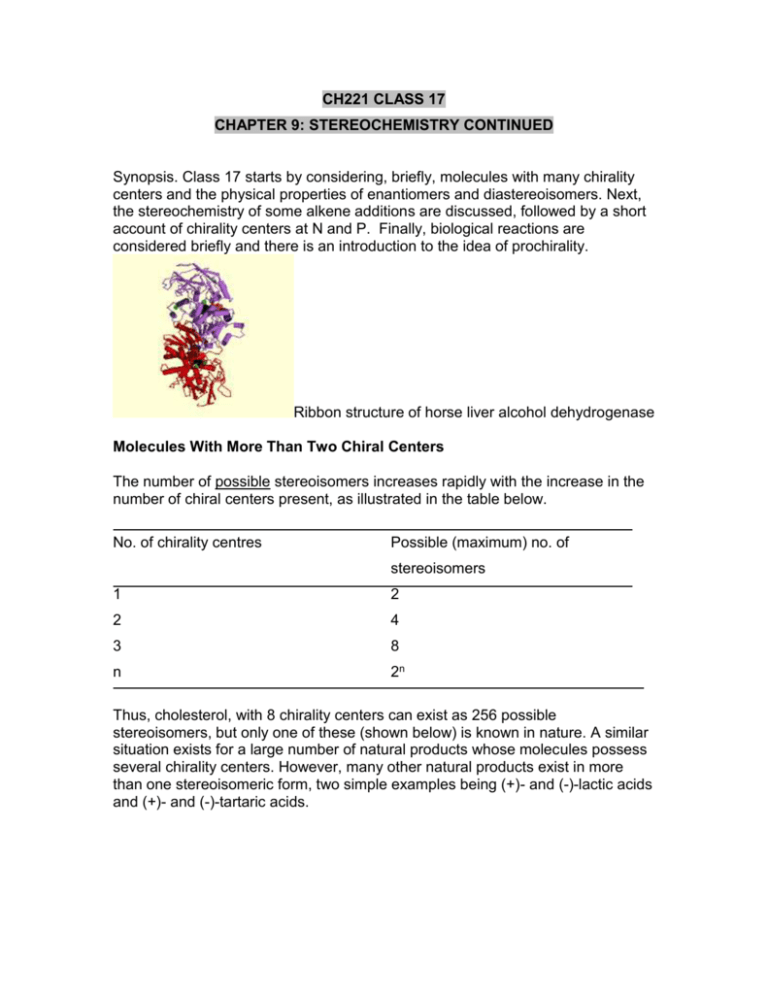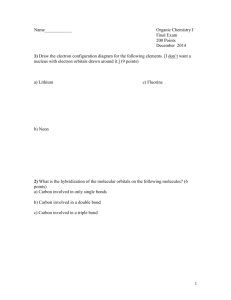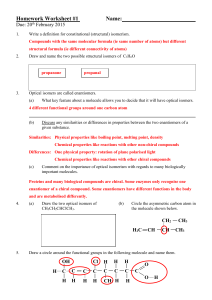CH221 CLASS 17
advertisement

CH221 CLASS 17 CHAPTER 9: STEREOCHEMISTRY CONTINUED Synopsis. Class 17 starts by considering, briefly, molecules with many chirality centers and the physical properties of enantiomers and diastereoisomers. Next, the stereochemistry of some alkene additions are discussed, followed by a short account of chirality centers at N and P. Finally, biological reactions are considered briefly and there is an introduction to the idea of prochirality. Ribbon structure of horse liver alcohol dehydrogenase Molecules With More Than Two Chiral Centers The number of possible stereoisomers increases rapidly with the increase in the number of chiral centers present, as illustrated in the table below. No. of chirality centres Possible (maximum) no. of stereoisomers 1 2 2 4 3 8 n 2n Thus, cholesterol, with 8 chirality centers can exist as 256 possible stereoisomers, but only one of these (shown below) is known in nature. A similar situation exists for a large number of natural products whose molecules possess several chirality centers. However, many other natural products exist in more than one stereoisomeric form, two simple examples being (+)- and (-)-lactic acids and (+)- and (-)-tartaric acids. CH3 * CHC6H13 CH3 * CH3 * * * * * * HO Physical Properties of Stereoisomers In general, diatereoisomers have different physical properties (E.g. melting/boiling points, densities, IR spectra, NMR spectra, etc), whereas enantiomers have identical physical properties, apart from the sign of rotation of plane-polarized light. This is illustrated for meso-, (+)- and (-)-tartaric acids in Table 9.3 on page 291 of the textbook. Racemic Modifications and Their Resolution A racemic modification or racemate is a 1:1 mixture of (+) and (-) enantiomers, so that the overall optical rotation is zero. Racemates are denoted by the symbol () or (d,l). Thus, a sample of ()-sodium ammonium tartrate (racemic sodium ammonium tartrate), as made and studied by Louis Pasteur, contains 50% (+)enantiomers and 50% (-)-enantiomers. When a chirality center is created as a result of a chemical reaction, the product will always be formed as a racemate, in the absence of any chiral influences (such as a chiral catalyst): O HO + C CH3 H HCN H H C CH3 C CN 50% OH NC CH3 50% This can be a big disadvantage to the synthetic chemist whose desire will be to produce only the physiologically active form of a natural product or drug. Indeed the other form(s) will be, at best, inactive and at worst, toxic. So the chemist has to carry reactions such as the above in the presence of some kind of chiral influence, often a chiral catalyst or agent. If a chiral influence cannot be found, then the chemist must resort to resolution of the racemic product. Resolution is the process of separating pure (+)- and (-)-enantiomers from a racemate. Louis Pasteur was the first to resolve a racemate – ()-sodium ammonium tartrate. He was lucky in that this salt crystallized below 28 oC as separate mirrorimage crystals, one type containing only (+)-enantiomers and the other type containing only (-)-enantiomers. Thus Pasteur was able to separate them using only magnification and tweezers. This kind of racemate is called a racemic mixture. Many other kinds of racemates (E.g. racemic compounds, whose (+)and (-)-enantiomers are in the same crystal type) cannot be separated (resolved) in this way, but there are many alternative methods of resolution, including Formation of diastereoisomers Asymmetric destruction, induction and synthesis Biochemical methods Kinetic methods Chiral chromatography Resolution of Racemates by the Method of Diastereoisomer Formation This method involves the reaction of racemates with a compatible chiral reagent of high optical purity to give a mixture of diastereoisomers. The diastereoisomers can then be separated by making use of differences in physical properties, such as boiling points or solubilities. The separate diastereoisomer samples are then treated with a simple reagent to generate pure enantiomers and to regenerate the chiral reagent (which is sometimes recycled). In practice, this can be a rather tedious process, often requiring several runs. The basic principles of the method are outlined below. (+)A (-)A + (+)A(+)B (+)B Racemate e.g. an acid (+ (+)B) (-)A(+)B diastereoisomeric salts with different solubilities an enantiomerically pure chiral base (+)A + (+)A(+)B fractional crystallization hydrolysis (-)A (+ (+)B) (-)A(+)B This is illustrated by the resolution of (RS)-lactic acid using the base (R)-(+)-1phenylethylamine. NH2 COOH H HO H HO CR H CH3 CH3 C COO- R Ph NH3+ R C H C H CH 3 HO CH3 R Ph NH3+ S CH3 C H HO COOH S CH3 C - COO H CH3 CR Ph diastereoisomeric salts Stereochemistry of Some Reactions Most biological reactions and many laboratory reactions yield chiral products. However, if there are no controlling chiral influences on the reaction, a racemic modification will result – that is to say, the chiral product will be produced as a 1:1 mixture of both (+) and (-) enantiomers. This general principle is illustrated, next by considering the addition of HBr and Br2 to alkenes. Addition of HBr to Alkenes Addition of HBr to 1-butene gives racemic 2-bromobutane: Br HBr CH3CH2CH 1-butene CH2 ether CH3CH2*CHCH3 (+)-2-bromobutane - Why this occurs can be seen from the mechanism. The carbocation intermediate is planar and so reaction with Br- can occur equally from either side of the plane, via mirror image transition states to give equal amounts of the two enantiomers, as shown overleaf. Both pathways have the same energy, proceed at the same rate and are equally likely to occur. Addition of Bromine to Alkenes Addition of bromine to achiral non-terminal disubstituted alkenes, like 2-butene, is similar to the previous reaction, except that bromonium ions (rather than open cations) are involved in the mechanism and the reaction generates two chirality centers, not one. The bromonium ion can react equally likely at either carbon atom with Br- to give a 1:1 mixture of two enantiomeric products, as shown overleaf. The exact identity of the enantiomeric mixture is determined by the stereochemistry of the alkene: cis-2-butene gives a different pair of products to trans-2-butene, as will be seen on examination of the reaction mechanism overleaf. CH3 H CH3 C C H CH3 C H CH3 a Cis-2-butene path a + Br Br2 H S C S C Br C H CH3 b Br- Br path b R R C C H CH3 Br H CH3 H CH3 Br (+)-2,3-dibromobutane - H CH3 C C CH3 H + Br Br2 C H CH3 Trans-2-butene path a C a H S C R C R C S C Br CH H 3 b Br- CH3 path b Br H CH3 Br CH3 H CH3 H Br meso-2,3-dibromobutane Chirality of Atoms Other Than Carbon Silicon, nitrogen, phosphorus and sulfur are all frequently found in organic molecules and they too can be chiral in certain circumstances. The chirality of silicon is very similar to that of carbon, but the chirality of nitrogen especially, and also of phosphorus and sulfur is complicated by the ability of atoms to invert their configurations. For simple amines in particular, because of the presence of a lone pair of electrons, the energy barrier to inversion is small at normal temperatures, so that it is impossible to isolate individual enantiomers: H C2H5 H rapid N N C2H5 CH3 CH3 mirror plane Inversion at phosphorus and certain sulfur atoms, however, is substantially slower than inversion at nitrogen, so stable chiral phosphines, for example, can be isolated, as shown below. (R)-Methylphenylpropylphosphine is configurationally stable at 100 oC P CH3 Ph CH2CH2CH3 Chirality in Nature Although the different enantiomers of a chiral compound have identical physical properties (apart from the sign of rotation), they usually differ in their physiological effects – i.e. they have different biological properties. Cells are kept alive and thriving by a host of interlocking series of reactions (both synthetic and degradative) that are known as metabolic pathways. For a particular organism, only one enantiomer or diastereoisomer of two or more possibilities normally takes part in one particular metabolic pathway. The other stereoisomers are either inactive or participate in different metabolic pathways. This is because most of the individual reactions of metabolic pathways involve the creation or destruction of chirality centers and are catalyzed by protein catalysts called enzymes. The active sites of enzymes of enzymes are chiral and hence enzymes generally catalyze reactions only when the substrate (the ‘correct’ enantiomer) ‘fits’ the reaction site: Even when a particular biological reaction doesn’t take place at the chirality center as such, the chirality of the molecule is still usually important, because of the chirality of the enzyme active site. Some interesting examples of the selectivity of biological processes are to be found overleaf in the sensation of odor and flavor: different enantiomer, different odor. (+)-limonene (-)-limonene odor of orange odor of lemon (+)-carvone (-)-carvone O O odor of caraway odor of spearmint Prochirality A molecule is prochiral if it can be converted from achiral to chiral in a single step E.g. 1. O OH 2H C CH3 CH3 C2H5 Ph H C Ph Br2 H H COOH C* H + HBr 2-bromo-2-phenylethanoic acid 3. H HOOC Br COOH 2-Phenylethanoic acid C C2H5 H 2-butanol 2-Butanone 2. * C C OH H H2O HOOC COOH cis-1,4-Butanedioic acid (fumaric acid) C* C H H COOH 2-hydroxy-1,4-butanedioic acid (malic acid) Which enantiomer is produced in 1 and 3 above depends upon which FACE of the prochiral unsaturated group undergoes addition. The two faces can be named using the Cahn-Ingold-Prelog priority rules, as follows. Similarly, in example 2 above, which enantiomer is produced depends on which hydrogen atom is substituted at the prochirality center carbon atom: Many biological reactions involve prochiral compounds being converted to a single enantiomer product, two prominent examples are given below. H re C - OOC C si H2O fumarate hydratase - COO - OOC C in TCA cycle H reaction at si face CH2COOH OH (S)-malate Fumarate -2H yeast alcohol dehydrogenase OH C CH3 H HSR O C in yeast alcoholic fermentation CH3 HS removal of pro-R hydrogen only Class Questions 1. Identify the indicated faces in the following molecules as re or si. 2. Lactic acid buildup in tired muscles results from the reduction of pyruvate. If the reaction occurs at the re face, what is the stereochemistry of the product?






